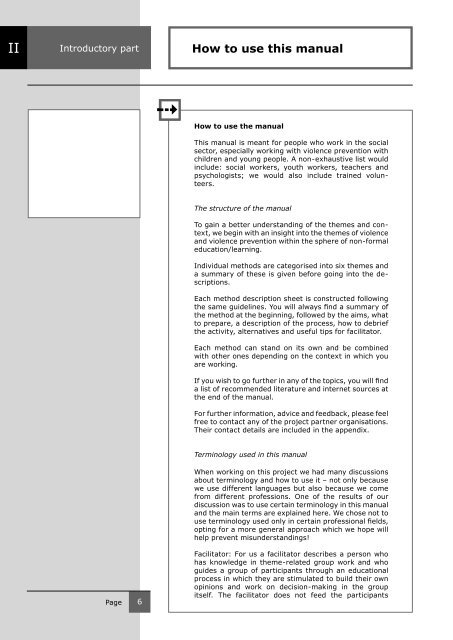Who are you? - Emergency Brake
Who are you? - Emergency Brake
Who are you? - Emergency Brake
You also want an ePaper? Increase the reach of your titles
YUMPU automatically turns print PDFs into web optimized ePapers that Google loves.
Methods<br />
Description Introductory part<br />
Sheet<br />
II How to use this manual<br />
Page 6<br />
How to use the manual<br />
This manual is meant for people who work in the social<br />
sector, especially working with violence prevention with<br />
children and <strong>you</strong>ng people. A non-exhaustive list would<br />
include: social workers, <strong>you</strong>th workers, teachers and<br />
psychologists; we would also include trained volunteers.<br />
The structure of the manual<br />
To gain a better understanding of the themes and context,<br />
we begin with an insight into the themes of violence<br />
and violence prevention within the sphere of non-formal<br />
education/learning.<br />
Individual methods <strong>are</strong> categorised into six themes and<br />
a summary of these is given before going into the descriptions.<br />
Each method description sheet is constructed following<br />
the same guidelines. You will always find a summary of<br />
the method at the beginning, followed by the aims, what<br />
to prep<strong>are</strong>, a description of the process, how to debrief<br />
the activity, alternatives and useful tips for facilitator.<br />
Each method can stand on its own and be combined<br />
with other ones depending on the context in which <strong>you</strong><br />
<strong>are</strong> working.<br />
If <strong>you</strong> wish to go further in any of the topics, <strong>you</strong> will find<br />
a list of recommended literature and internet sources at<br />
the end of the manual.<br />
For further information, advice and feedback, please feel<br />
free to contact any of the project partner organisations.<br />
Their contact details <strong>are</strong> included in the appendix.<br />
Terminology used in this manual<br />
When working on this project we had many discussions<br />
about terminology and how to use it – not only because<br />
we use different languages but also because we come<br />
from different professions. One of the results of our<br />
discussion was to use certain terminology in this manual<br />
and the main terms <strong>are</strong> explained here. We chose not to<br />
use terminology used only in certain professional fields,<br />
opting for a more general approach which we hope will<br />
help prevent misunderstandings!<br />
Facilitator: For us a facilitator describes a person who<br />
has knowledge in theme-related group work and who<br />
guides a group of participants through an educational<br />
process in which they <strong>are</strong> stimulated to build their own<br />
opinions and work on decision-making in the group<br />
itself. The facilitator does not feed the participants


